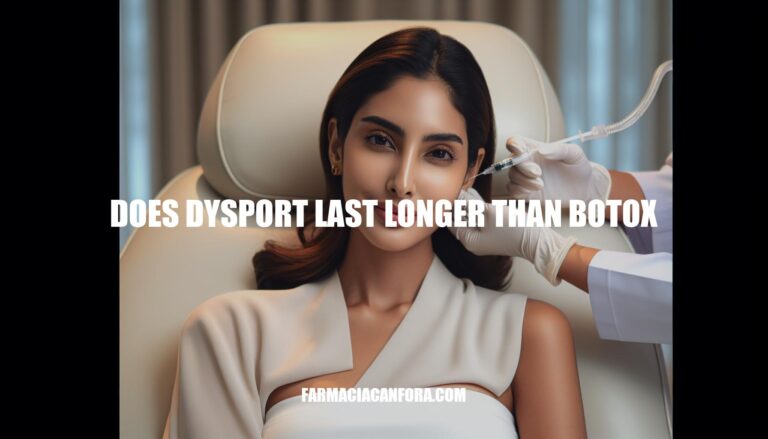


Understanding whether Dysport lasts longer than Botox is crucial for those seeking effective and lasting wrinkle treatments. Both Dysport and Botox are popular non-surgical options used to reduce the appearance of fine lines and wrinkles by relaxing facial muscles. Dysport is primarily used for glabellar lines (the area between the eyebrows), while Botox is approved for treating forehead lines, crow’s feet, and glabellar lines. Knowing the differences in their duration and effectiveness can help individuals make informed decisions about their cosmetic treatments.
Dysport and Botox both work by using botulinum toxin type A to block nerve signals to muscles, causing them to relax and reducing the appearance of wrinkles.
These differences in diffusion and onset time can influence the choice between the two based on the treatment area and desired speed of results.
: Cleveland Clinic
: Verywell Health
Several clinical studies have compared the duration of effects between Dysport and Botox:
Primary Palmar Hyperhidrosis Study: This double-blind, randomized study found that both Dysport and Botox significantly reduced sweating. However, Dysport showed a more pronounced decrease in sweating area at 1 and 3 months compared to Botox, although the difference was not statistically significant. The mean duration of positive effect was similar for both: 17 weeks for Dysport and 18 weeks for Botox.
Upper Limb Spasticity Study: A study aimed at comparing the safety and efficacy of Dysport and Botox in adults with upper limb spasticity found that Dysport might have a longer duration of response compared to Botox when used at optimal doses.
General Findings: Research published in JAMA Dermatology indicated that Botox’s effects began to fade after 10 weeks, while Dysport lasted a bit longer. Patients were generally satisfied with twice-yearly Dysport treatments.
Patient Satisfaction: Studies by Galderma, the manufacturer of Dysport, suggested that Dysport might last up to five months, with high patient satisfaction reported with just two treatments per year.
Overall, while some studies suggest that Dysport may last slightly longer than Botox, the differences are often not statistically significant, and individual results can vary.
Many patients have shared their experiences with Dysport and Botox, often comparing the longevity of the results. Here are some notable anecdotes and testimonials:
Dysport Lasts Longer: Some patients report that Dysport seems to last longer for them. One patient mentioned, “I switched to Dysport and noticed it lasted about a month longer than Botox for me”.
Botox Preferred: Conversely, others prefer Botox. A patient shared, “Botox has always given me consistent results, and I feel it lasts just as long as Dysport, if not longer”.
Varied Experiences: There are also mixed reviews. One user stated, “I’ve tried both, and honestly, I don’t see much difference in how long they last. It really depends on the individual”.
Spread and Effectiveness: Some patients note that Dysport spreads more easily, which can be beneficial for larger areas. “I like Dysport because it covers a larger area and seems to kick in faster,” one patient explained.
These testimonials highlight that the effectiveness and longevity of Dysport versus Botox can vary significantly from person to person.
Insights from Dermatologists and Cosmetic Surgeons:
Duration of Effects:
Clinical Recommendations:
The comparison of Dysport and Botox’s duration of effects is crucial for those seeking effective wrinkle treatments. Both work by using botulinum toxin type A to block nerve signals, causing muscles to relax and reducing wrinkles. The differences in formulations and diffusion rates can influence the choice between the two based on treatment area and desired speed of results.
Botox contains onabotulinumtoxinA with a more concentrated formulation, ideal for smaller areas like frown lines and crow’s feet. Dysport contains abobotulinumtoxinA with a different protein structure, allowing it to diffuse more widely, making it suitable for larger areas like the forehead.
The duration of effects varies between Botox (3-5 days onset, 3-4 months lasting) and Dysport (24-48 hours onset, 3-4 months lasting). Several clinical studies have compared their durations:
Patient satisfaction and testimonials also vary:
Dermatologists and cosmetic surgeons agree that both treatments last about four months, with Dysport’s effects appearing faster. However, individual results can vary significantly.
In conclusion, while some studies suggest that Dysport may last slightly longer than Botox, the differences are often not statistically significant, and individual results can vary. Ultimately, choice between the two treatments depends on patient-specific factors and desired onset speed.